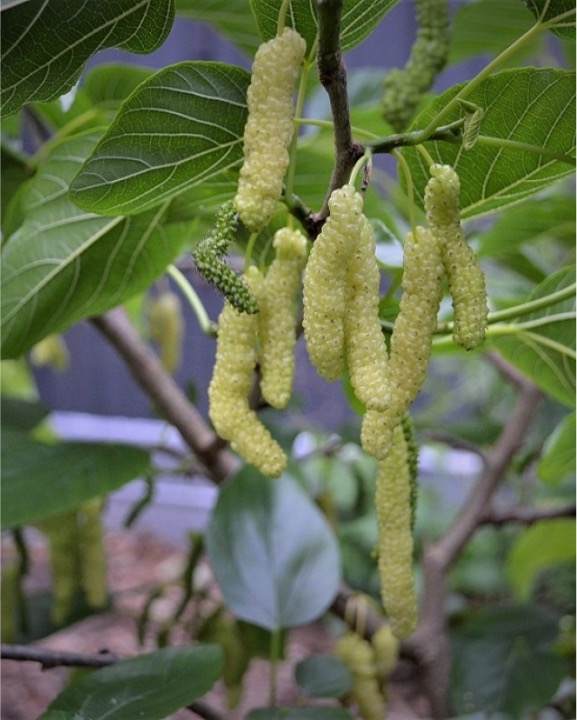White Mulberry
- Family: Morus Alba
- Local Names: Amharic (yeferenji injori), Arabic (tuth), Bengali (tut), Burmese (posa), English (white mulberry,mulberry,Indian mulberry,Russian mulberry), Filipino (amoras,amingit), French (mûrier blanc), German (Weiße Maulbeere), Gujarati (shetun)
Description
1. Morus alba is a fast-growing shrub or moderate-sized tree with a fairly cylindrical, straight bole, up to 35 m high and 1.8 m in girth, without buttresses; bark dark greyish-brown, rough with vertical fissures; exuding white or yellowish-white latex.
2. Leaves very variable, ovate or broadly ovate, distichous, simple to 3-lobed, dentate, palmately 3-veined at base; stipules lateral, caducous, coriaceous.
Inflorescence axillary, pendulous. Flowers greenish, inconspicuous, with 4 free imbricate petals. Male flowers in a catkinlike raceme, with lax flowers; stamens 4, pistillode top-shaped. Female flowers in a long or short spike; ovary enclosed, 1-(2-) locular with a single ovule, style bipartite.
3. Fruit a syncarp, consisting of many drupes enclosed in a fleshy perianth up to 5 cm long; white, pinkish-white, purple or black.
4. It has been suggested that the generic name of the mulberry, Morus, was derived from the Latin word ‘mora’ (delay), from the tardy expansion of the buds. An alternative explanation is that it comes from the Celtic word ‘mor’ (black), referring to the colour of the fruit.
Ecology
M. alba grows in areas with a subtropical or mild temperate climate. The shade-tolerant trees are highly susceptible to drought and inhabit ravines, valleys and coastal areas.
Tree Management
1. To minimize competition, the plants must occasionally be weeded. Once in several years, the plant should be pruned down to regularize its shape and allow the growth of new shoots. The form depends on the height of the plant and the height at which the old branches are cut. M. alba requires protection against fire and browsing, to which it is susceptible. Plantations are managed by coppicing; in India, 20-year-old coppice shoots of M. alba showed a mean annual diameter increment of 1.5 cm and a mean annual height increment of 1 m. Early growth was very fast: 4.5 m in the 1st 2 years.
2. Seed storage behaviour is orthodox, with viability being maintained for several years in hermetic storage at room temperature; more than 3 years of hermetic storage at room temperature with 13-2% mc. There are about 1.1 million seeds/kg.
3. M. alba grows in areas with a subtropical or mild temperate climate. The shade-tolerant trees are highly susceptible to drought and inhabit ravines, valleys and coastal areas. M. alba regenerates naturally through seed or coppice. Seedlings are pricked out when 10-15 cm tall. All but a few terminal leaves are stripped (‘striplings’) before seedlings are planted in the cold season or at the beginning of the rainy season. Scarification of the seed in moist sand at 5 deg. C for 30-90 days, or soaking in cold water for about a week, hastens and ensures uniform germination, and treatment with kerosene oil or camphor water protects them from ants.
4. The species can also be established by planting out nursery-raised seedlings (entire plants or stumps), rooted branch cuttings, budding, grafting and layering. It can also be propagated by tissue culture.
Timber
M. alba yields a medium-weight hardwood with a density of 670-850 kg/cubic m. Heartwood yellow or yellowish-brown, darkening to golden or red-brown upon exposure, sharply demarcated from up to 4 cm wide; white or pale yellow sapwood; grain straight, texture moderately coarse and even in the semi-ring porous material, uneven in ring porous material; wood lustrous at first, becoming dull with age, with attractive silver grain. In seasoning, the wood has a tendency to warp. It is easy to saw, work, turn, bend and finish, and it seasons well. It is suitable for house building, boats, beams, posts, flooring, bridge building, agricultural implements, cabinet work, furniture and turnery, especially picker arms, bobbins and tool handles; useful for spokes, poles, shafts and bent parts of carriages and carts; also much valued for sports equipment such as hockey sticks, tennis and badminton rackets, and cricket bats
Shade or Shelter
Recommended for shelter planting such as protecting orchards from wind.
Medicine
Bark is said to be good in the treatment of stomach-ache, neuralgic pains and dropsy; leaves and young branchlets used for treating heavy colds, cough, red eye, insect bites and wounds; fruit used in the treatment of sore throat, dyspepsia and melancholia.
Gum or Resin


